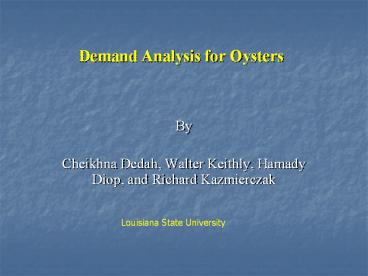Demand Analysis for Oysters - PowerPoint PPT Presentation
Title:
Demand Analysis for Oysters
Description:
Title: An Inverse Almost Ideal Demand System for Oysters in the United States: An Empirical Investigation of the Impacts of Mandatory Labels Author – PowerPoint PPT presentation
Number of Views:214
Avg rating:3.0/5.0
Title: Demand Analysis for Oysters
1
Demand Analysis for Oysters
- By
- Cheikhna Dedah, Walter Keithly, Hamady Diop, and
Richard Kazmierczak
Louisiana State University
2
Background
- Consumption of raw oysters contaminated with
Vibrio vulnificus bacteria can lead to serious
illness and even death among individuals with
weakened immune systems. - California, in response to health concerns,
initiated a program on March 1991 which required
mandatory labels on Gulf products. - The average annual deflated dockside price of
Gulf oysters has fallen by approximately 40
since the introduction of the warning labels in
1991.
3
Warning Labels
4
Newspapers Headlines
5
Annual Deflated Dockside Oyster Prices by Region
and Import Price (1980-84 base period)
6
Annual U.S. Oyster Harvests by Region and Annual
Imports Oyster
7
Objectives
- Investigate the impacts of the mandatory warning
labels and the associated media attention in a
complete demand framework. - Examine the cross-quantity substitution effects
8
Material and Methods
The Inverse Almost Ideal Demand System (IAIDS)
Model
i, j Gu, Ch, Pa, Im
wit is the expenditure share for oysters
supplied from region i or imports at time t. qj
is quantity of oyster per 1,000 people supplied
from region j (or Imports) at time t. Q is the
Laspeyres quantity index. ?ts is seasonal dummy
variable . Vib is a Vibrio dummy
variable. Trend is time trend variable.
9
Methods
- The IAIDS model for Gulf, Chesapeake, Pacific,
and imported oysters is estimated based on
quarterly time series data covering the period
1985(1)-2003(4). - Homogeneity and symmetry restrictions are imposed
on the estimated model.
10
RESULTS AND DISCUSSION
11
Estimated Parameters from the IAIDS Model for
Oysters
Note seasonal shifts in the intercept are not
reported in this table
12
Impact of Mandatory Labels
- The mandatory labels and related media attention
was estimated to - Decrease the budget shares of the Gulf and
Chesapeake products by 8.7-8.9 - Increase the budget shares of the Pacific and
imported products by 8.5-9
13
Impact of Mandatory Labels
- An alternative model functional form which allows
for a gradual decline in the effect of warning
labels was also considered. - The Vibrio dummy variable was insignificant
across all share equations when its starting
period moved back or forth two or three years. - The parameters estimates were very stable after
deleting the last five years of data from the
analysis.
14
Uncompensated Price Flexibilities
15
Price Flexibilities
- All own price flexibilities are negative as
theoretically expected. - All cross price flexibilities were found to be
negative which classifies all products as gross
substitutes - The Gulf product was found to exhibit a
relatively strong cross-quantity substitution
effect with the imported and Chesapeake products.
16
Price Flexibilities
- The Chesapeake product has very weak
cross-quantity substitution effect with oysters
from other regions. - The Pacific product was found to have a strong
cross-quantity substitution effect with the Gulf,
Chesapeake, and imported oysters.
17
Conclusions
- The model results suggest a decline in the Gulf
and Chesapeake shares by about 9 and a
corresponding increase in the Pacific and import
shares. - The Gulf, Chesapeake, Pacific, and imported
oysters are gross substitutes. - The estimated cross price flexibilities suggest
that the Gulf and Pacific products have strong
quantity-substitution effects on other products.































